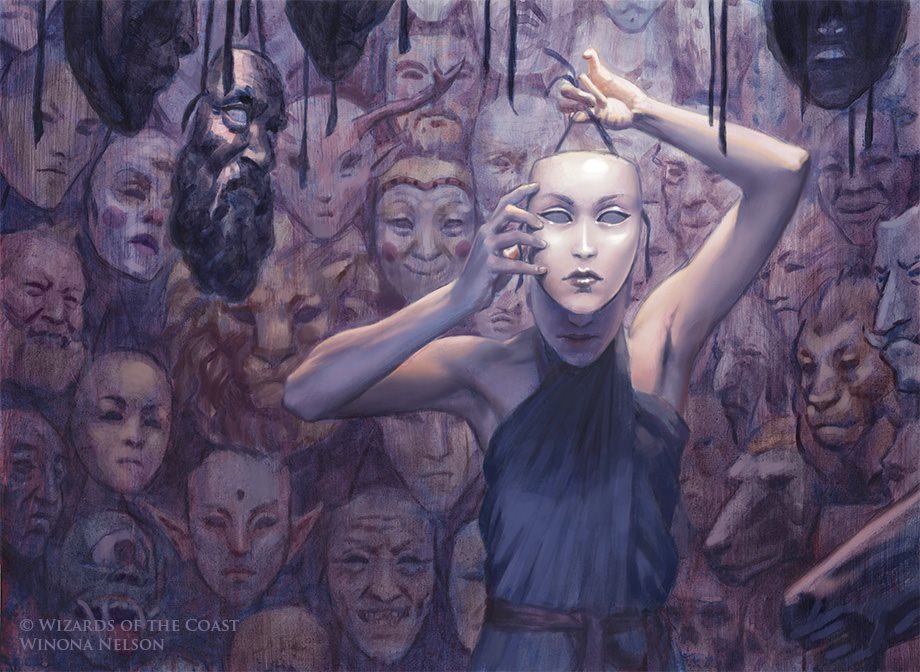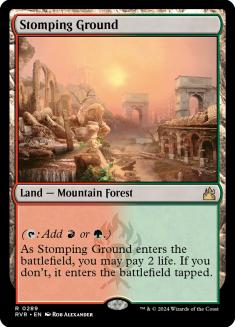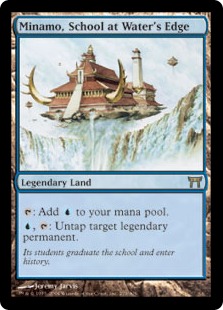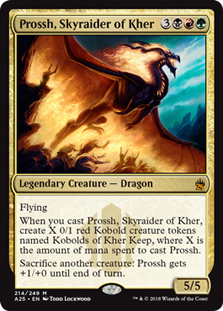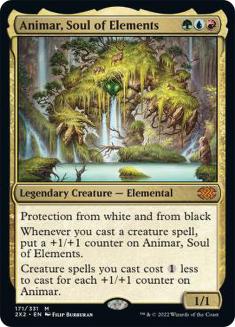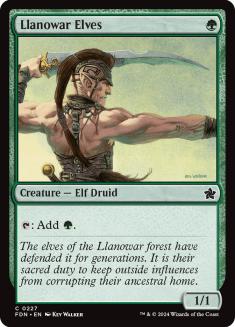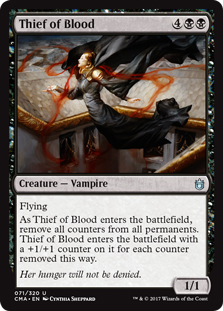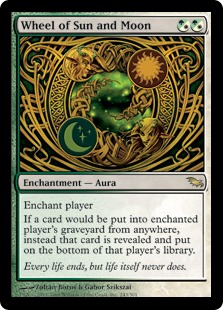Some time in the middle of the last decade (which is a thing we get to say now that we’re a third of the way through this one), I embarked on the then-ambitious project of creating a deck for each of the 27 possible Commander color identities. It was before four-color commanders were possible, the addition of which (in the middle of my working on the so-called Chromatic Project) brought us up to 32. When I completed the project, I wondered what to do next.
We were in a time in which we weren’t getting so much Commander product annually and certainly not the plethora of good commanders to build decks around, so borrowing an idea from former SCG writer Abe Sargent, I hatched the Do Over Project. In short, the idea was to take the same 32 commanders around which I had built those decks and build with the next 99 cards (well, closer to 80, but you get the point), to take the commander in a new direction, without repeating any cards.
The Do Over
Over the time that I worked on the project, I went back and forth on how strict I wanted to be. Clearly there would be no repeating of nonland cards. At first, I wanted there to be no repeats at all besides basic lands, but decent mana-producers were harder to come by eight or nine years ago. I let myself slip a little into lands that only produced mana normally, by tapping (so no sacrifices or whatever). Stomping Ground would be okay, but Phyrexian Tower or Minamo, School at Water’s Edge wouldn’t be.
In 2023, it’s entirely possible that I could go back over the lists (which I’m doing at the moment, for a different reason) and fix them so that they’re unique save for the basic lands. It wouldn’t take all that much. Since I have notes on the decks, it’ll be relatively easy; I’ll just have to acquire the additional lands which produce two colors to make it happen. In some cases, I can probably just split the existing lands off the decks, add more basic lands to each, and have reasonable manabases.
Sidebar: OG Duals
One of the things making the process slightly more difficult is that I’m actively taking the original dual lands out of most of my decks. I want to reinforce the message that you don’t need OG duals to have good decks and lots of fun in Commander. Yes, they’re slightly better. Players overrate how great those percentages are. If you’re playing in a competitive Vintage event, you want those duals, because any percentage advantage, no matter how small, is worth the investment. When the goal of building the deck isn’t primarily winning, it’s an advantage we can choose to discard.
Anyway, putting my money where my mouth is means taking them out. I’ve kept them in my one high-powered deck and there are a few which have been altered (and are therefore not really sellable) which I’ve kept in for sentimental reasons. Otherwise, they’re all in a moisture-controlled package in the card closet.
A Do Over Do-Over
With the explosion of Commander and Commander product, the Do Over Project had slipped by the wayside. There were so many other compelling new commanders and deck themes to build around that it seemed wasteful to retread the theme. I simply didn’t and still don’t have the time or other resources to build both the Do Overs and one or two new things from each set.
That doesn’t mean I’ve abandoned the whole idea. Currently, eight of my 74 assembled non-precon decks are Do Overs, which I’ve returned to calling The Next 99, in honor of Abe’s original idea. Assuming there are cards that fit their strategies or themes, they get regular updates, like all decks in the suite.
New Commanders
Two of the decks have taken on new commanders. Not knowing that new morph cards were in the works, I had built the next 99 of The Mimeoplasm as a morph deck. When Kadena, Slinking Sorcerer came out, all I did was switch the commander. The other is what was the Karrthus, Tyrant of Jund Do Over, which I had built without any Dragons at all (after the original being Dragon-themed). Given what the commander does, it was kind of a silly choice for silliness’s sake. Back then, some friends and I were in a debate about just how good Prossh, Skyraider of Kher is without building around it. I just slapped it at the helm of the nearest Jund deck I had, and it somehow stuck.
The deck didn’t really have a coherent approach; like more than one of the Do Overs, it came into being because there was a pile of cards lying around that I didn’t want to file. I took what I could and made a deck out of them. One of the things I’m looking at during this review is to perhaps bring a little more cohesion to those which just came about from avoiding the tedious work of filing cards.
What’s Next
The purpose of discussing The Next 99 is to highlight the idea that there is a great deal of room in Commander to play more than the staples or what some might consider the best cards. We hear lots of content creators lament that the format has sped up and/or gotten more powerful, but they often miss the point that they can simply choose to make it not so (and the more influential the creator, the more opportunity they have to set the standard).
I want to be really careful about trying to define power level, since it’s so subjective, but “power level” as shorthand for “What kind of game would we like?” is reasonable. As I’ve frequently said before, I believe the time axis to be the more important one when having a pregame conversation. What we’re doing matters less than how much time we have to do it in. The overall point is that we have quite a bit of say in what we get to play and don’t need to cede that power to anyone. We can have a reasonable discussion about where we’re going to end up—and Commander is the only place where The Next 99 is viable. But I want to talk about how I might have messed up on the reasonable discussion.
Animar Instincts
The other eight decks I still have from this project are helmed by Animar, Soul of Elements; Glissa, the Traitor; Karador, Ghost Chieftain; Kresh, the Bloodbraided; Queen Marchesa; Rith, the Awakener; and Ruhan of the Fomori. They were all designed pre-pandemic, although I didn’t get around to physically assembling the Glissa deck until last year. They reflect the battlecruiser environment in which I tend to most often play. And they have, as I mention, gotten updates with new sets when cards fit the themes.
I recently decided to tighten up the Animar deck’s curve. Even for my normal environment, it was a little top-heavy. That tightening led to the point at which I’m pretty sure it’s stronger than the original—in that it can threaten to kill someone (not likely the whole table) earlier than I expected.
I suppose that’s really a feature of the commander itself. Left unchecked and casting some small creatures, large things can start hitting the table on Turn 6, maybe even Turn 5 if one of the one-drop mana creatures came out on Turn 1. Then opponents are left dealing with two problems—first the threat to their life totals and then the fact that more is coming. It’s gone from janky to kind of dangerous and now, unlike its cousins, I’d hesitate to play it in a lower-interaction environment. Here’s the list, which is also available on Archidekt:
Creatures (31)
- 1 Sakura-Tribe Elder
- 1 Llanowar Elves
- 1 Clone
- 1 Fyndhorn Elves
- 1 Genesis
- 1 Seedborn Muse
- 1 Heart Warden
- 1 Coiling Oracle
- 1 Body Double
- 1 Elvish Visionary
- 1 Ulamog, the Infinite Gyre
- 1 Edric, Spymaster of Trest
- 1 Burnished Hart
- 1 Archetype of Endurance
- 1 Scourge of Fleets
- 1 Kruphix, God of Horizons
- 1 Clever Impersonator
- 1 Oblivion Sower
- 1 Ulamog, the Ceaseless Hunger
- 1 Desolation Twin
- 1 Undergrowth Champion
- 1 Bane of Bala Ged
- 1 Kozilek, the Great Distortion
- 1 Mina and Denn, Wildborn
- 1 Selvala, Heart of the Wilds
- 1 Rashmi, Eternities Crafter
- 1 Majestic Myriarch
- 1 Tatyova, Benthic Druid
- 1 Augur of Autumn
- 1 Mirrorhall Mimic
- 1 Hulking Metamorph
Lands (38)
Spells (30)
- 1 Sylvan Library
- 1 Goblin Bombardment
- 1 Kodama's Reach
- 1 Tangle
- 1 Sword of Light and Shadow
- 1 Sculpting Steel
- 1 Vorrac Battlehorns
- 1 Pyroblast
- 1 Nature's Lore
- 1 Insight
- 1 Mercadia's Downfall
- 1 Defense of the Heart
- 1 Greater Good
- 1 Keep Watch
- 1 Wild Ricochet
- 1 Comet Storm
- 1 Explore
- 1 Asceticism
- 1 Darksteel Plate
- 1 Aetherize
- 1 Plasm Capture
- 1 Blade of Selves
- 1 Zendikar Resurgent
- 1 Selvala's Stampede
- 1 Crash Through
- 1 Alpine Moon
- 1 Myth Unbound
- 1 Tale's End
- 1 Arcane Signet
- 1 Defabricate

Need for Speed
I hesitate to say that the changes made it too strong (that would imply some objectivity to the power), but they made it too fast for the first table I sat it down with, on stream with the other Commander Rules Committee (RC) members. To me, it was just adding cards that I wanted to play, like the criminally underappreciated Mercadia’s Downfall, card-drawing machine Insight, inexpensive and right-for-the-commander Equipment Vorrac Battlehorns, and amusing Clones Mirrorhall Mimic and Body Double.
The turn came when, at the last minute, I took out a few of the higher-mana cards like Artisan of Kozilek and It That Betrays and added low-mana cards which were sitting on the table and also happen to be mana-producers: Llanowar Elves, Fyndhorn Elves, and Selvala, Heart of the Wilds. The deck’s fundamental turn shifted more radically than I processed it had.
Once again, it’s not what the deck was doing, but when that was at issue. I had underestimated the t-axis and relayed that to my friends, who brought what seemed like appropriate decks. Without a key piece of early interaction (if you play a little less, expecting a longer game, you’re simply less likely to have it) combined with Animar having protection from black and protection from white, I dropped Desolation Twin on Turn 5. By the time they had dealt with Animar, there was too much else on the battlefield for them to come back from. They were gracious about it, but I felt that I had—albeit unintentionally—misrepresented what the deck could do. The incident caused me to think a great deal about what matters when updating decks.
The Power and the Glory
When we build, we generally build with a power level in mind. We ratchet it up or down, as is appropriate for how and where we’re going to play the deck. We have a more holistic look at the design. Here, I exposed the danger in not really considering the other pieces of what I was adding to. By being dismissive about the cards themselves (“oh, it’s just a couple of pieces of mana acceleration”) and with the back-of-the-mind thought that these were the second-tier cards compared to the first 99, I wasn’t looking at the bigger picture.
The deck is good and strong (although nowhere near high-powered) and interesting to play, but keeping Animar around for any length of time really puts it on easy mode. There’s nothing wrong with playing strong or optimized decks; we just have to be aware of where we’re playing them and with whom we’re playing them. I don’t intend to undo the changes; I’ll simply be aware of the more appropriate situations in which to bring out the deck—which is what I believe my friends would first ask of me anyway.
Switching Commanders
The rest of the Next 99 decks haven’t changed so significantly. They rest comfortably in that mid-tier spot, getting in the kinds of games we like to have on stream. What’s important on the stream is that we have games that we can talk around as well. Engaging with the chat or each other, whether it’s about the game or something off-topic, is the primary reason to stream (at least for us; I know it’s income for some other folks).
That’s why a deck like the Prossh (formerly Karrthus) version might choose to run more stuff at sorcery speed than is normally considered efficient. If I don’t have much to think about between turns, then I can spend my energy chatting instead of thinking. As far as leading to game wins, it’s likely less effective, but I’m looking at winning in a different way here: by being able to socialize. Here’s the list, which I will admit is kind of all over the place (and the Archidekt version):
Creatures (30)
- 1 Avatar of Woe
- 1 Wall of Blossoms
- 1 Thunder Dragon
- 1 Terravore
- 1 Genesis
- 1 Molder Slug
- 1 Spike Cannibal
- 1 Goblin Gardener
- 1 Avatar of Fury
- 1 Battlefield Scrounger
- 1 Herald of Leshrac
- 1 Detritivore
- 1 Masked Admirers
- 1 Fertilid
- 1 Taurean Mauler
- 1 Deus of Calamity
- 1 Fulminator Mage
- 1 Knollspine Dragon
- 1 Kulrath Knight
- 1 Puppeteer Clique
- 1 Spearbreaker Behemoth
- 1 Spellbreaker Behemoth
- 1 Moldgraf Monstrosity
- 1 Predator Ooze
- 1 Blood Artist
- 1 Dragonlair Spider
- 1 Bane of Progress
- 1 Vaevictis Asmadi, the Dire
- 1 Atsushi, the Blazing Sky
- 1 Canoptek Scarab Swarm
Lands (38)
Spells (31)
- 1 Nevinyrral's Disk
- 1 Necropotence
- 1 Darksteel Ingot
- 1 Kodama's Reach
- 1 Decree of Pain
- 1 Beacon of Unrest
- 1 Altar of Shadows
- 1 Nature's Lore
- 1 Primal Order
- 1 Thran Dynamo
- 1 Skyshroud Claim
- 1 Overmaster
- 1 Harmonize
- 1 Lavalanche
- 1 Sign in Blood
- 1 Explore
- 1 Consume the Meek
- 1 Back to Nature
- 1 Nihil Spellbomb
- 1 Life's Finale
- 1 Chaos Warp
- 1 Blasphemous Act
- 1 Ranger's Path
- 1 Crypt Incursion
- 1 From the Ashes
- 1 Fated Return
- 1 In Garruk's Wake
- 1 Incite Rebellion
- 1 Return of the Wildspeaker
- 1 Nahiri's Lithoforming
- 1 Awaken the Woods

Revise and Resubmit
This deck needs some help. I’d still avoid making it about Prossh and add some hidden gems. I’d want to find victory paths beyond making token creatures, save for the ones that Prossh makes itself. We have the one out of Awaken the Woods if needed. The three-black pip cards, Necropotence and Fated Return, are likely to come out, since black is by far the lowest color. Each sorcery makes sense individually, but eighteen of them might just mean a little too much time to chat between turns. Awaken the Woods synergizes with Nahiri’s Lithoforming a bit, which then spins up the Terravore count—but there’s not enough commitment to that sub-theme.
I’d springboard off Spike Cannibal and add Thief of Blood. We might even go to Hex Parasite. Then I’d once again look at the pile of cards that I don’t want to file. There’s a Radiate I wouldn’t mind having around for the lulz. Hamletback Goliath can get silly. There’s Insult // Injury, for the first half only. Rubblehulk could provide a commander damage kill with trample. Thrilling Encore can be a serious blowout.
We could ramp up the artifact and enchantment hate already in the deck, like Bane of Progress, with Disciple of the Vault, Sardian Avenger, and the obscure Tranquil Grove.
This isn’t a deck so much as an actual pile of jank. I’ll want to bring some cohesion to it and see where it can go—without taking it in any of the obvious directions (so Food Chain can sit in the binder).
Othernext
The Karador, Kresh, Rith, Queen Marchesa, and Ruhan decks don’t need much.
With Ghave, Guru of Spores as kind of the secret commander, the Karador deck likes its +1/+1 counters. There might be some more recent cards that could help a little more, but I don’t think it actually warrants any changes. The Next 99 of Kresh might actually get into the red zone better than its increasingly misnamed forebear.
The Rith deck is all about blinking, which doesn’t make much sense in light of the commander, but the colors are okay with. It’s the deck where I wanted to see Wheel of Sun and Moon do some work. It plays a little too much at sorcery speed, which would be the upgrade path there. Especially since we have white and red, we can move into some You Did This to Yourself territory.
Marchesa’s Knights should probably just get converted over to Syr Gwyn, Hero of Ashvale at some point. Alternatively, we could keep it as a Next 99 and somehow make Syr Gwyn the secret commander. The Ruhan deck is closest to what an actual Ruhan deck would want to do, mostly using the Boros elements to be aggressive. It’s the one with a lovely Mercadia’s Downfall, generally a fantastic element in go-wide strategies. It, too, wouldn’t find Comeuppance or Deflecting Palm out of place.
What’s Next for the Next 99?
The Next 99 Project may be the victim of so many new, compelling commanders coming along that we can only pay attention to a single copy from the past, not two. It’s not quite dead for me, though. First, I’m keeping the existing decks, even if I’ll be a little more aggressive about changing a few of them for cohesion’s sake. There are also a few other commanders that I’d love to reimagine. Finding a path for Breena that didn’t involve paying homage to the precon would be grand. I’ve gone in such a cheeky direction with Kros, Defense Contractor that I’m sure there’s room to build something else with it. I’d even consider a third Queen Marchesa version since I love her so much (hey, I have three Karador decks).
There are two important parts to The Next 99. First is that it forces us to think differently about how we want to build a deck. We go in with a large set of restrictions and need to search for things beyond the obvious, breeding creativity. The second is rejection of the necessity of staples and the so-called best cards in the format. When winning is a goal subservient to socializing and having fun, each of us individually gets to decide what are the best cards to play. That freedom is hard-coded into the format’s DNA.
Visit my Decklist Database to see my Signature Decks, the Chromatic Project, and more!

